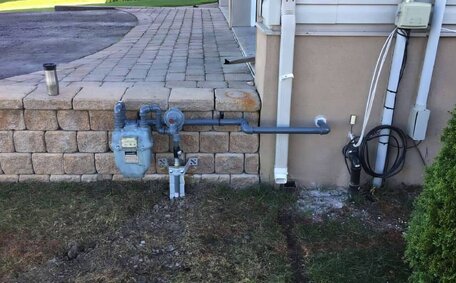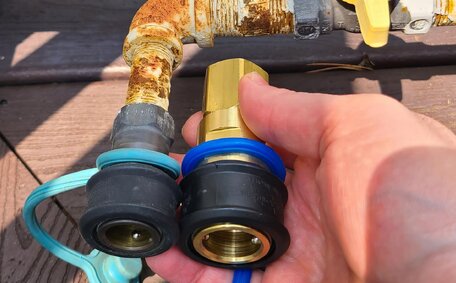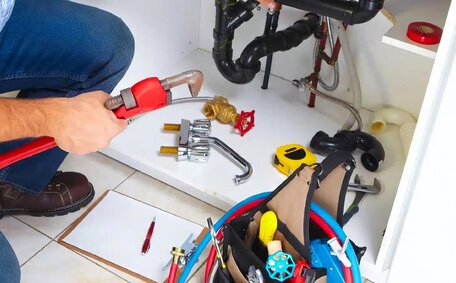Introduction to Blocked Drains in Industrial Environments
Blocked drains are a common problem that can disrupt daily operations and pose health risks if left unaddressed. Unlike residential blocked drains which may be caused by hair or food waste, the causes of blocked drains in factories, warehouses and processing plants tend to be more complex.
Blocked drains in industrial settings often result from a buildup of heavy sediments, fats, oils, greases (FOGs), chemical residues, tree roots, ground movements, or general pipe deterioration over time.
The large scale and complexity of industrial drainage systems often mean blockages remain undetected until serious overflows or water damage occur.
Proactive steps to prevent blocked drains include routine CCTV inspections, hydrojetting services, installing screens and traps, stringent sediment disposal protocols, and emergency response planning.
Dealing with fully blocked drains often requires commercial-grade high pressure cleaning, manual rodding and extraction of debris buildup, chemical drain cleaning agents to break down materials, or full pipe relining solutions. Given the risks of lost productivity and revenue due to shutdowns, it’s vital to have professional plumbing services on call for a fast response to blocked drains.
Common Causes of Blocked Drains
Several common factors lead to blocked drains in industrial settings, including:
- Sediment, dirt, debris buildup – The most common reason blocked drains occur, these emerge from production processes which can lead to solid accumulations that block drains if not filtered or flushed out periodically.
- Fats, cooking oil and greases (FOGs) - Cafeterias, greasy production processes and poor disposal habits allow FOGs to congeal into blockages.
- Tree root invasions - Roots from surrounding greenery tend to infiltrate underground sewer pipes, often being a primary factor in blocked drains caused.
- Chemical deposits - Corrosive substances or residues poorly disposed into drain systems can cause blockage by amalgamating.
- Foreign objects, including equipment parts, tools, plastics, and sanitary products flushed down toilet, among other items disposed of improperly, can lead to blockages in drains.
- Deteriorating infrastructure – Ageing pipes with cracks, misalignments, or breakages can easily become clogged with debris.
Staying on top of inspections and maintenance, filtering systems, proper waste disposal procedures, and having professional drain cleaning services ready for rapid response are key to preventing major industrial drain blockages.
Grease and Food Buildup
Grease, oils, and food waste can cause significant blockages in kitchen, bathroom, cafeteria, and food processing area drains. Hot oils, fats, or scraps improperly disposed down sink quickly cool and congeal, creating tenacious layers along the pipe walls.
Over time, these substances trap passing debris, transforming manageable situations into serious blockages within the plumbing system.
Regular maintenance, including hot water flushing with baking soda, can dissolve grease deposits before they harden. Educating personnel on proper waste disposal and installing filtration systems, such as grease traps and screens, are crucial preventive measures.
Food grinders, considered valuable DIY drain maintenance tools, can shred food scraps into finer particles, easing their passage through pipes with a drain auger.
If grease blockages still eventuate, high-pressure water jetting, performed by skilled blocked drain plumbers, is typically needed to cut through and evacuate the hardened material.
Narrow streams emitted from hydrojetting nozzles at formidable pressures can clear blocked drains effectively, scouring pipe interiors down to the raw metal.
Tree Roots
Tree roots from your garden pose a major threat to industrial drainage infrastructure. Tree roots, on the hunt for moisture, will exploit any imperfections, such as cracks, faults, or loose joints in pipes drains, causing invasions. Once established, roots rapidly expand, displace joints and cause blockages, compromising plumbing system efficiency.
Ignoring small pipe defects or root infiltration can rapidly escalate into significant drain blockages and disruptions. Root balls can entwine around pipe bends, trapping solid debris and forming substantial clogs. Being dynamic living organisms, the roots persistently regrow after cutting, necessitating professional removal to be done quickly.
Combining mechanical water jetting and manual rodding can shred and evacuate smaller root bundles. Moreover, an extensively affected drain can demand excavation around it for the complete removal of root infestations and pipe repairs to permanently resolve the issue.
Regular drain inspections, root foaming treatments, root barrier installations, and timely pipe repairs can prevent root intrusion and major blockages.
Pipe Damage and Age
Over time, industrial drainage pipes endure significant wear and tear. The combination of heavy use, ground shifts, exposure to corrosive substances, and general deterioration can accumulate taking a significant toll on drainage systems. Cracks, fractures, misalignments and broken parts within ageing pipe systems provide the perfect conditions for debris and sediments to snag, accumulating into more severe clogs.
Frequent CCTV inspections are crucial for monitoring pipe conditions and detecting damages early to prevent blockages. Any faults discovered can then be promptly repaired or pipes replaced if needed. Hydrojetting is an effective method for removing sediment buildup, particularly from damaged drains.
Enlist a plumber to develop a comprehensive asset management plan, monitoring pipeline longevity and guiding strategic maintenance and upgrades.
Signs of a Blocked Drain
Be alert to signs of a blocked drain in industrial settings, such as:
- Slow draining water from sinks, sewers, or processing equipment
- Accumulated storm water or inundation around stormwater drainage outlets
- Gurgling sounds from drain pipes
- Sewage water overflowing from manholes or stormwater pits
- Foul odours emanating from drains
- Infestations of cockroaches or rats around affected drains
- Reduced productivity or intermittent equipment failures if process drains are blocked
Technicians using drain cameras can quickly identify and clear blocked drains to prevent significant damage.
Preventing Blocked Drains
Key measures can prevent blocked drains in industrial facilities:
- Install debris-catching devices such as screens, filters, and traps to prevent solids from entering pipes, and ensure regular cleaning for optimal performance.
- Routine CCTV inspections are the most effective way for the early identification of pipe damage or defects, enabling prompt repairs before blockages occur.
- Regular hydrojetting maintenance removes sediment buildup and maintains clear drains.
- Controlling improper waste disposal - Strict policies ensure oils, chemicals and solids are disposed correctly, not carelessly washed into drains.
- Root foaming treatments - Foam barrier applications stop root intrusions which cause persistent clogs.
- Upgrade outdated drains - Modern wide-bore plastic piping is far less prone to blocking than older styles.
Taking a proactive preventative approach with professional maintenance and response services ready solves issues before they escalate into major blockages.
Regular Maintenance and Inspections
Implementing regular drain inspections and maintenance by our team is critical for industrial facilities to prevent blocked drains. Industrial drain cleaning protocols recommend that professional services using CCTV cameras should meticulously inspect all drainage conduits and trouble zones every 6 months. More frequent maintenance employing your hot water system for hydrojetting every 3 months assists in washing away sediment build-up before substantial blockages form.
Statistics show proactive maintenance does a good job at extending the lifespan of industrial drainage systems by over 15 years compared to reactive blocked drain repairs. The nominal costs of routine servicing is minor considering the severe impacts on your business if critical systems fail. Developing contingency plans with emergency teams on standby to fix blocked drains quickly and mend damages can also dampen the severity of issues.
Comprehensive maintenance programs are key to effective blocked drain management, as prevention trumps the hassle of overflow or flood disruptions.
Installation of Screens and Traps
We highly recommend installing screening and trapping devices within industrial drainage systems as they provide an effective protective barrier to catch solids before they enter pipes. Suitability depends on the specific substance needing filtration - meshes for large debris, wire screens for smaller sediments, grease traps for oils/fats, or lint filters for fibrous wastes.
For optimal results in dealing with oil and grease, screens should left unchanged and efficiently capture spills before slipping down sink entry points, including sink outlets and floor drains. For field validation purposes should left accessible, monitoring and service access points should remain accessible and appropriately fitted further down lines beyond screens. Consider heavier graded stainless steel screens and deeper sump traps for high debris loads.
To avoid bottleneck blockages, screens/traps must have adequate surface area and depth clearance for holding capacity relative to the drainage load. Maintenance staff should have clear access to facilitate regular inspections and emptying as needed into appropriate waste disposal streams.
Careful selection, strategic placement, and regular maintenance of screens and traps, customised to facility requirements, deliver reliable initial filtration to stop debris from entering drainage systems.
Clearing Existing Blockages
When facing an active your blocked drain, start by trying home remedies like boiling water, drain cleaners or manual rodding before escalating to professional services. Caustic or corrosive products must be handled carefully according to instructions - safety comes first.
Should water-based methods prove unsuccessful, it’s time to engage a professional plumber with commercial-grade equipment to tackle stubborn industrial drain blockages. High-pressure hydrojetting emitting narrow jets of water up to 4000psi dislodges debris, while augers physically hook and extract clogs. Industrial vacuum trucks can extract blockages efficiently by removing loosened sediment and waste.
When struggling with extensive root invasions or collapsed drains affecting your system, you might have to take excavation into your hands to fix your blocked pipes by cutting out the damaged sections. Consider pipe relining, which involves applying a smooth epoxy barrier inside pipes to deter future debris build-up.
It’s prudent to initially address a single drain one at a time with uncomplicated solutions but, when necessary, to escalate measures to get the job done efficiently. Armed with the right gear, our expert industry knowledge ensures professionals can handle your stubbornly blocked industrial drains and clear them quickly.
Advanced Drain Cleaning Methods
Industrial facilities often require more advanced drain cleaning methods to clear severe or persistent blockages in large-scale drainage systems.
High-pressure water jetting is one of the most powerful techniques in specialised industrial cleaning, using nozzles that emit narrow jets at up to 4000psi. This focused hydraulic force penetrates thick grease deposits, obliterates tough root bundles and scours pipe walls down to raw metal to dislodge trapped debris.
When facing severe drain clogs where sediment accumulates, it may be time to call for manual rodding with rods or augers to hook and ensnare debris, or consider the use of industrial-strength caustic chemicals to dissolve the thick substances. However caution is required when handling dangerous caustic cleaners.
As a last resort, plumbing cameras help locate damaged pipe sections which may need replacement. Full pipe relining can also remediate internal pipe issues, applying a smooth protective coating to shield drains from future blockages.
An experienced drain plumber can promptly tackle even the most challenging blockages by precisely matching drainage issues with tailored solutions.
High Pressure Water Jetting
High pressure water jetting is a powerful and effective drain clearing technique employed by specialists to dislodge all kinds of blockages and restore water flow. Using specialised nozzles, narrow jets of water clear your blocked drains with pressures up to 4000psi.
The extreme blasting force of the high velocity water streams penetrates clogged drains with accumulated grease, grime and debris deposits. Thick substances are emulsified and dissolved while compacted solids like heavy sludge and root bundles are forcibly disintegrated. The disintegrated waste is then flushed away with the water current, leaving the pipes thoroughly clean.
The efficacy of removing oil and grease with the environmental advantages of high-pressure jetting can make it the tool to get the job done when tackling blocked industrial drains, avoiding any potential damage your pipes. Only qualified professionals should operate this equipment - the intense hydraulic pressures make it very dangerous if mishandled.
High-pressure hydrojetting offers an ideal rapid-response solution for industrial sites requiring heavy-duty drainage solutions without necessitating shutdowns or excavations. Even the most severely congested large diameter pipes can be promptly restored to full operational flow.
Chemical Drain Treatments
Chemical drain cleaner products play a limited role in resolving industrial blockages due to their environmental impacts and risks of pipe corrosion over time. While caustic products might dissolve some organic material, they could also harm the delicate microbiomes and aquatic ecosystems once flushed away.
Safer biological drain treatments using enzyme-secreting microbes or bacteria cultures are an emerging alternative. These biological treatments can also cause deterioration of blockages by metabolising substances such as greases, fats, cellulose fibres, and starch particles that clog drains, all without harming the pipes.
Naturally occurring microorganisms digest build up and maintain flow. Regular dosing reinforces drain integrity.
For pre-emptive maintenance, non-toxic organic drain gels coat pipes to lubricate flow and prevent adhesion of oils and sediments. Though milder than caustic chemicals, enzyme cleaners require longer contact times to fully liquefy blockages. Overall biological options promise effective, eco-friendly industrial drain solutions without risks of burns or pipe decays over time.
Snaking and Rodding
Snaking and rodding are hands-on mechanical drain clearing methods used by plumbers to physically dislodge and extract blockages. A flexible drain snake or wound spiralling rod was very carefully fed down the drain and delicately rotated to ensnare debris. The snake barbs then latch onto the clog so it can be forcibly pulled out when retracted.
Rodding is an economical first response to try clearing simple sink or toilet clogs manually before utilising advanced commercial hydrojetters. However for long drains or dense industrial waste, rod chains may lack the reach or grip strength needed to hook distant blockages.
It causes no pipe damage and quickly restores flow at low cost without chemicals.
Having a very professional plumber attempt rodding before escalating to heavy duty jetting can save on servicing costs. However rodder operation takes skill and experience to carefully manoeuvre tools through multiple bends to strike an obstruction effectively for removal. Overall snaking and rodding remains an indispensable basic technique in every plumber’s blocked drain clearing arsenal.
When to Call a Professional
Once home solutions prove ineffective at clearing industrial blocked drains, engaging professional hydrojetting and plumbing services is critical. Tackling severe waste conglomerations requires the prowess of experts wielding commercial machines can quite impressively dispense up to 4000psi of water pressure and utilise specialised augers. For extreme root infestations necessitating drain replacement or relining, excavation equipment may be required.
If you’re in the Brisbane area struggling with a drain issue, contact Marsfield Plumbing, your plumbing specialists. Our drain plumbers are available 24/7 to quickly resolve stubborn blocked drains and prevent further overflow damage. Leveraging advanced CCTV pipe scanning to identify issues and ensure site safety, our plumbing solutions team can get to the bottom of your drainage problems, providing effective, compliant, and lasting solutions. Contact our professionals now by email or phone 1300 349 338 to prevent prolonged business disruptions.






